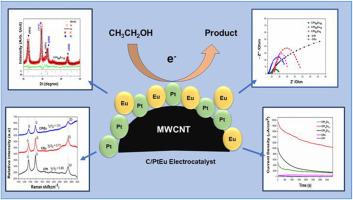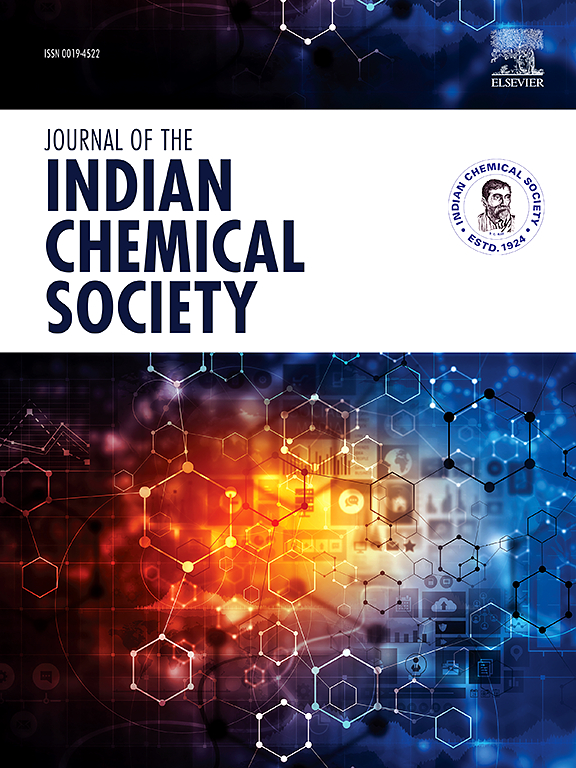Promoting role of Europium on Multi-Walled Carbon Nanotube (MWCNT) supported Platinum catalyst for Ethanol Electro-Oxidation in Direct Alcohol Fuel Cell (DAFC)
IF 3.2
4区 化学
Q2 CHEMISTRY, MULTIDISCIPLINARY
引用次数: 0
Abstract
Implementing rare earth metals with platinum for Ethanol Oxidation Reactions (EOR) has received significant interest in the promising DEFC. Incorporation of Europium, a rare earth metal, influences the electron density of the Pt, and the resulting catalytic activity is reinforced. Herein, different molar ratios of binary PtEu electrocatalysts supported over MWCNT were synthesized using the borohydride reduction method. The purpose of the investigation was to determine how the atomic structure, composition, and activity of the electrocatalyst correlate to the EOR. Structure, bulk composition, morphology, and bonding of the electrocatalyst were investigated through X-ray diffraction (XRD), Scanning Electron Microscopy (SEM), Energy-Dispersive X-ray (EDX), Fourier Transform Infrared (FTIR) spectroscopy, and RAMAN spectroscopy. Cyclic Voltammetry (CV), Linear Sweep Voltammetry (LSV), chronoamperometry (CA), and Electrochemical Impedance Spectroscopy (EIS) techniques were employed to probe the electro-oxidation kinetics on the electrocatalyst's surface. During the EOR circumstances, the PtEu electrocatalysts showed a captivating composition-structure-activity relationship, consistent with the findings. Notably, all the physical and electrochemical analyses demonstrate that the bimetallic composition of the 84:16 electrocatalyst has shown higher EOR activity through a bifunctional mechanism. The results provide novel insights into the ethanol oxidation process over bimetallic alloy electrocatalysts, which is crucial for designing robust and efficient electrocatalysts for DEFC.

多壁碳纳米管 (MWCNT) 支持的铂催化剂中的铕对直接酒精燃料电池 (DAFC) 中乙醇电氧化的促进作用
将稀土金属与铂结合用于乙醇氧化反应(EOR),在前景广阔的 DEFC 中受到了极大关注。稀土金属铕的加入会影响铂的电子密度,从而增强催化活性。在此,我们采用硼氢化还原法合成了不同摩尔比的二元铂铕电催化剂。研究的目的是确定电催化剂的原子结构、组成和活性与 EOR 的相关性。通过 X 射线衍射 (XRD)、扫描电子显微镜 (SEM)、能量色散 X 射线 (EDX)、傅立叶变换红外光谱 (FTIR) 和 RAMAN 光谱分析了电催化剂的结构、块状成分、形态和键合。此外,还采用了循环伏安法(CV)、线性扫描伏安法(LSV)、时变分析法(CA)和电化学阻抗谱法(EIS)等技术来探究电催化剂表面的电氧化动力学。在 EOR 情况下,PtEu 电催化剂显示出迷人的成分-结构-活性关系,这与研究结果一致。值得注意的是,所有的物理和电化学分析表明,84:16 的双金属催化剂通过双功能机制表现出更高的 EOR 活性。这些结果为双金属合金电催化剂上的乙醇氧化过程提供了新的见解,这对于设计用于 DEFC 的稳健高效的电催化剂至关重要。
本文章由计算机程序翻译,如有差异,请以英文原文为准。
求助全文
约1分钟内获得全文
求助全文
来源期刊
CiteScore
3.50
自引率
7.70%
发文量
492
审稿时长
3-8 weeks
期刊介绍:
The Journal of the Indian Chemical Society publishes original, fundamental, theorical, experimental research work of highest quality in all areas of chemistry, biochemistry, medicinal chemistry, electrochemistry, agrochemistry, chemical engineering and technology, food chemistry, environmental chemistry, etc.

 求助内容:
求助内容: 应助结果提醒方式:
应助结果提醒方式:


